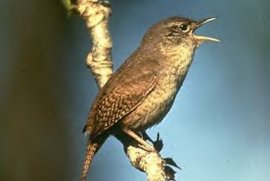Perching Birds
Description
4 1/2 -5 1/4" (11-13 cm). A tiny bird with a short tail, often held cocked over the back. Dusky brown above, paler below, with no distinctive markings. Winter Wren is similar but smaller and darker, with shorter tail and pale eyebrow.
Voice
A gurgling, bubbling, exuberant song, first rising, then falling.
Habitat
Residential areas, city parks, farmlands, and woodland edges.
Nesting
5-8 white eggs, thickly speckled with brown, in a cup lined with feathers and other soft material contained within a mass of sticks and grass, placed in a natural cavity or bird box.
Range
Breeds from British Columbia east across Canada to New Brunswick, and south to southeastern Arizona, northern Texas, Tennessee, and northern Georgia. Winters north to southern California, Gulf Coast states, and Virginia. Also in tropical America.
Discussion
This wren often nests in odd places such as mailboxes, flowerpots, and even the pockets of coats on clotheslines. When competing for a nest site, the House Wren may throw out the nest, eggs, and even the young of other hole-breeding birds. In the process this bird may kill its competitors, or if they are more powerful, it harasses them by filling the hole with its own nest material. If House Wrens return in spring to find an old nest still in place, they usually remove it stick by stick, then proceed to rebuild, often using the very material they've just discarded. Outside the breeding season, House Wrens are shy and much less in evidence than when they are singing during the breeding season.


